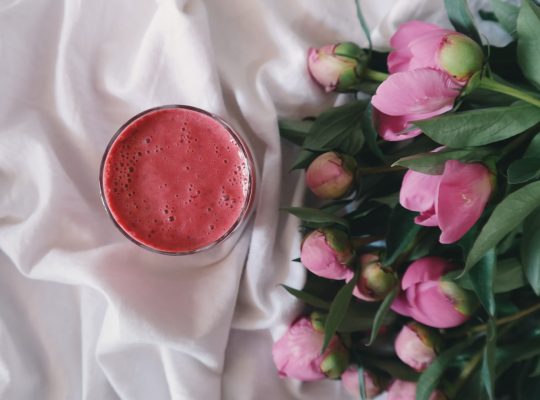Progesterone is one of the key hormones in a woman’s body. In proper balance with estrogen and testosterone, it functions to regulate menstrual cycles, fertility, and menopausal transition. It eases PMS, promotes sleep and feeling calm, speeds up metabolism, and generates a general sense of wellbeing.
Without adequate levels, we see signs such as insomnia, bloating and water retention, PMS, irregular cycles, menstrual cramping, fibroids/PCOS, infertility, and anxiety, cellulite and weight gain, sagging skin, and thyroid issues.
Progesterone levels can be tested with a simple saliva test, and it is tested as part of the DUTCH test (dried urine test).
How to Balance Progesterone Levels with Food
The challenge when it comes to balancing sex steroid hormones is partly based in the fact that we can eat estrogen but we cannot eat progesterone. Though no foods contain progesterone, the following micronutrients can provide the environment needed to support your body to boost progesterone levels:
Vitamin C
Research shows that vitamin C can help boost progesterone levels and correct luteal phase issues. Women who took 750 mg of Vitamin C increased their progesterone levels by as much as 77 percent.
Good sources: Camu camu (Peruvian berry), kiwi, strawberries, oranges, bell pepper, leafy greens, raw parsley, and pumpkin. Many other veggies also boost vitamin C, including broccoli, mustard greens, tomatoes, Brussels sprouts and lemons.
Try this: Add ½ teaspoon of camu camu to your smoothie.
How much vitamin C should you take?
Minimum: 250 mg per day.
Recommended: 500-1000 mg per day.
Limit: Do not take more than 3000 mg per day orally. High supplement dosages of vitamin C can dry up your cervical fluid and make your cervical fluid overly acidic which is unfriendly to sperm.
Orthomolecular dosages of vitamin C via IV may be appropriate under certain circumstances to treat severe illness, however, this should be done under the supervision of a knowledgeable healthcare provider.
Foods High in Vitamin C
Vitamin C is a water soluble vitamin and sensitive to heat, therefore should be heated as little as possible. A Danish study showed that if you boil broccoli for only 5 minutes it loses 36-55% of its vitamin C content.
Yellow Peppers –3mg per large pepper (red and green peppers have less)
Dark Leafy Greens (dandelion greens) – 120mg per 100g of Kale
Kiwi – 64mg per kiwi
Broccoli – 89.2mg per 100g of broccoli
Oranges – 69.7mg per orange
Zinc
This important mineral is not just a must have for your immunity and skin. Zinc also helps the pituitary gland to release follicle-stimulating hormones. These encourage ovulation and they also tell your ovaries to produce more progesterone.
How Much Zinc Do You Need?
Recommended: 15-25 mg per day, 30 mg for vegetarians
Limit: 70 mg per day, too high a dose can actually decrease immunity.
Foods High in Zinc
seafood (shrimp, scallops, oysters), wheat germ, pumpkin and squash seeds, nuts (cashews)
Magnesium
This important mineral not only helps to preserve progesterone levels by keeping you calmer, it also assists the breakdown of the antagonistic estrogen metabolites, reducing estrogen dominance. Magnesium is the fourth most abundant mineral in your body but nearly 75% of Americans have a magnesium deficiency. Not only does magnesium help the body absorb calcium, it also regulates the pituitary gland, which in turn regulates hormone levels.
How Much Magnesium Do You Need?
Recommended: 320 mg per day.
Foods High in Magnesium
Dark Leafy Greens (Swiss chard, arugula, dandelion, kale) – 79mg per 100g of kale
Nuts and Seeds – 534mg per 100g of pumpkin seeds
Fish – 97mg per 100g of mackerel
Whole Grains – 44mg per 100g of brown rice
Dark Chocolate – 327mg per 100g of dark chocolate
Vitamin E
Research shows that vitamin E can help improve luteal bloodflow and raise progesterone levels.
How Much Vitamin E Do You Need?
Recommended: 100-130 mg per day.
Limit: 1,000 mg per day.
Foods High in Vitamin E
Nuts – 2mg per 100g of almonds
Seeds – 3mg per 100g of sunflower seeds
Fish – 8mg per 100g of trout
Plant Oil – 40mg per 100g of sesame oil, 4mg per 100g of olive oil
Vitamin B6
The B vitamins help combat stress and also help your liver break down estrogen byproducts, reducing estrogen dominance. One research study has shown that taking Vitamin B6 at doses of 200-800 mg/day can reduce blood estrogen levels, increase progesterone levels and result in improvements in PMS symptoms.
How Much Vitamin B6 Do You Need?
Minimum: 1.9 mg per day.
Recommended: 10 mg per day. Can increase to 50mg when short term booster is needed. Limit:
Do not exceed 100 mg per day.
Foods High in Vitamin B6: bananas, carrots, spinach, salmon, tuna, sweet potato, peas
Fiber
Fiber is essential for hormonal balance; it helps with bowel movement and the excretion of metabolized hormones.
Good sources: flaxseed, quinoa, millet, amaranth, teff, sweet potatos, chia seeds.
Good cholesterol
Cholesterol is needed to make pregnenolone. Pregnenolone converts to progesterone, which is a precursor for other hormones, like testosterone and estrogen. Proper levels of vitamin D are crucial to convert cholesterol to sex steroid hormones.
Good sources: coconut oil, coconut butter, fatty fish, olives and olive oil.
Sulfur
Cruciferous vegetables are a great way to reduce Estrogen Dominance. They are rich in glucosinolates, which activate phase 2 detoxification in the liver, helping to filter estrogen metabolites from your body. This is good news for your hormone balance because it prevents estrogen byproducts circulating for too long, which can raise estrogen levels and cause hormonal havoc.
Good sources: broccoli, collard greens, kale, Swiss chard, cauliflower, cabbage and Brussels sprouts.
Bio-Identical Progesterone to Balance Hormones Naturally
Some women who, for example, lost their uterus or who live in stressful circumstances that won’t go away any time soon, will benefit from bio-identical progesterone creams. However, relying solely on bio-identical hormone creams may not solve other underlying root causes of low progesterone levels such as emotional stress, physical stress from bacterial, viral or parasitic infections, toxicity issues, excess alcohol, autoimmune issues, etc. Stress is a major progesterone robber – constant high stress levels decrease progesterone!







